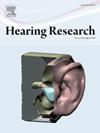Optimizing the stimulus used to elicit the acoustic change complex: Evaluation of the pre-transition stimulus duration and stimulus complexity in normal hearing adults
IF 2.5
2区 医学
Q1 AUDIOLOGY & SPEECH-LANGUAGE PATHOLOGY
引用次数: 0
Abstract
Introduction
The Acoustic Change Complex (ACC), a cortical auditory evoked potential elicited by sound changes, is a promising measure of speech discrimination for populations unable to perform speech perception tests. However, its clinical utility is limited by long measurement times, which could be reduced by optimizing the signalto-noise ratio (SNR).
Objectives
To study the effect of 1) varying the pre-transition duration (PTD) and 2) tonal complexity on ACC outcomes, including N1-P2 amplitude, baseline noise, SNR, and efficiency (SNR divided by measurement time).
Methods
ACC responses were measured in 18 normal-hearing adults using pure-tone stimuli with a frequency change (1 to 1.1 kHz) and PTDs of 0.25, 0.5, 1, 2 and 3 s, as well as a complex tone with a 1-second PTD.
Results
N1-P2 amplitude increased with PTD up to 2 s. PTD 0.25 s was excluded due to response overlap. Increasing PTD from 0.5 s to 1 s increased efficiency and SNR, reducing estimated measurement time by 78.8 %. ACC presence increased with PTD (100 % for PTD 3 s), but SNR and efficiency gains were absent beyond PTD 1 s. The complex tone showed no difference in N1-P2 amplitude or SNR compared to the pure tone, but increased ACC presence by 22.5 % points.
Conclusion
A PTD of 1 s is recommended over 0.5 s. Increasing tonal complexity and the PTD beyond 1 s seems promising to enhance ACC specificity without compromising SNR or efficiency. These findings support stimulus optimization to improve clinical feasibility of ACC measurements.
优化刺激诱发声变化复合体:对正常听力成人转换前刺激持续时间和刺激复杂性的评价
声学变化复合体(ACC)是一种由声音变化引起的皮层听觉诱发电位,对于无法进行语音感知测试的人群来说,它是一种很有希望的语音辨别措施。然而,其临床应用受到长测量时间的限制,可以通过优化信噪比(SNR)来减少测量时间。目的研究1)改变转换前持续时间(PTD)和2)音调复杂度对ACC结果的影响,包括N1-P2振幅、基线噪声、信噪比和效率(信噪比除以测量时间)。方法采用频率变化(1 ~ 1.1 kHz)、PTD分别为0.25、0.5、1、2、3 s的纯音刺激和PTD为1秒的复音刺激,对18例正常听力成人的sacc反应进行测量。结果sn1 - p2振幅随PTD延长至2 s而增加。由于响应重叠,PTD 0.25 s被排除在外。将PTD从0.5秒增加到1秒,提高了效率和信噪比,将估计测量时间减少了78.8%。ACC的存在随着PTD的增加而增加(PTD 3 s为100%),但在PTD 1 s之后信噪比和效率的提高就没有了。与纯音相比,复音的N1-P2振幅和信噪比没有差异,但ACC的存在增加了22.5%。结论推荐PTD为1 s以上0.5 s。增加音调复杂性和超过1 s的PTD似乎有望在不影响信噪比或效率的情况下增强ACC特异性。这些发现支持刺激优化以提高ACC测量的临床可行性。
本文章由计算机程序翻译,如有差异,请以英文原文为准。
求助全文
约1分钟内获得全文
求助全文
来源期刊

Hearing Research
医学-耳鼻喉科学
CiteScore
5.30
自引率
14.30%
发文量
163
审稿时长
75 days
期刊介绍:
The aim of the journal is to provide a forum for papers concerned with basic peripheral and central auditory mechanisms. Emphasis is on experimental and clinical studies, but theoretical and methodological papers will also be considered. The journal publishes original research papers, review and mini- review articles, rapid communications, method/protocol and perspective articles.
Papers submitted should deal with auditory anatomy, physiology, psychophysics, imaging, modeling and behavioural studies in animals and humans, as well as hearing aids and cochlear implants. Papers dealing with the vestibular system are also considered for publication. Papers on comparative aspects of hearing and on effects of drugs and environmental contaminants on hearing function will also be considered. Clinical papers will be accepted when they contribute to the understanding of normal and pathological hearing functions.
 求助内容:
求助内容: 应助结果提醒方式:
应助结果提醒方式:


